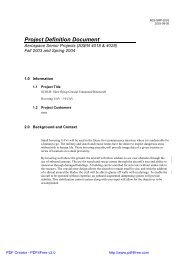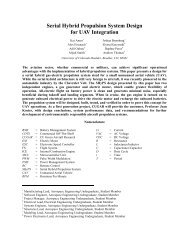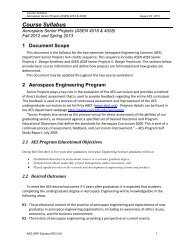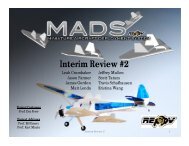PFR - Aerospace Engineering Sciences Senior Design Projects ...
PFR - Aerospace Engineering Sciences Senior Design Projects ...
PFR - Aerospace Engineering Sciences Senior Design Projects ...
Create successful ePaper yourself
Turn your PDF publications into a flip-book with our unique Google optimized e-Paper software.
Project Final Report – CUDBF April 30 th , 2009<br />
ASEN 4028: <strong>Aerospace</strong> <strong>Senior</strong> <strong>Projects</strong><br />
Figure 21: Single Motor Aircraft<br />
However, in order to get the thrust required to meet the 100ft takeoff distance requirement with a<br />
single motor, a propeller size of 20 in was necessary. In order to accommodate a 20 in propeller<br />
with adequate ground clearance, the landing gear would need to be at least 11 in long. This<br />
would allow for 10 in or half the propeller blade to spin under the wing with 1 in of ground<br />
clearance. This added landing gear size would require more structure and thus added weight and<br />
drag from the long landing gear. A system level requirement states that the aircraft must fit<br />
within a 2 ft x 2 ft x 4 ft box. With 11 in landing gear, an aircraft thickness, and 13 in winglets<br />
that fold 15 in in from the tip of the wing, it would be impossible to fit the aircraft vertically in a<br />
box under 2 ft tall. This drove the design of the propulsion system to utilize dual motors.<br />
Other disadvantages of a single motor include less directional stability due to the large amount of<br />
p-factor coming off one motor. In order to use a single motor rated for the required power<br />
necessary, the motor itself would weigh 0.25lbs more. That means the overall weight savings<br />
from using a single motor in this case would only be 0.25lbs. Because of these characteristics, a<br />
dual motor configuration was chosen.<br />
Once dual motors were selected, the exact configuration of the motors was analyzed. Three<br />
configurations were analyzed. These included dual inline pusher puller motors, dual rear<br />
mounted motors, and dual front mounted motors.<br />
The advantage of using dual inline motors is that if an engine were to fail, asymmetric thrust<br />
would not be an issue. A conceptual design of dual inline motors is shown in Figure 22.<br />
Figure 22: Dual In-Line Pusher Puller Motors<br />
The major disadvantage of using dual inline motors is that it would add length to the aircraft. The<br />
front motor would need to be placed in front of the nose of the aircraft, adding an additional 3 in<br />
40
















